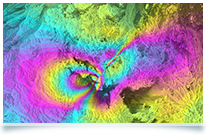
Geodesists can be seen as tinkers in the field of earth and planetary sciences. Seismologists and volcanologists, for instance, investigate earthquakes and volcanic eruptions using a variety of approaches such as observation, theory and experimentation. In contrast, geodesists consider what they can do with the tools at hand. They sometimes study earthquakes, volcanic eruptions and tectonics, and at other times work on meteorology, oceanography, hydrology, glaciology or considerations relating to satellites/planets such as the Moon and Mars. Geodesists are thus involved in a wide range of disciplines, and often tend to move on to a new area of study after finishing work in another. The tools at hand include space geodetic techniques such as the Global Navigation Satellite System (GNSS), Very Long Baseline Interferometry (VLBI), Satellite Laser Ranging (SLR), Synthetic Aperture Radar Interferometry (InSAR) and gravity measurement based on the use of satellite tracking. Developing new space geodetic tools themselves is also a research target.








